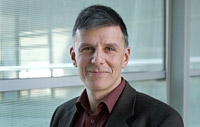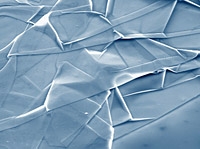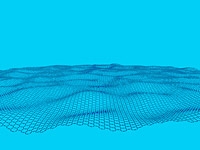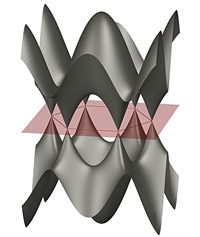Graphene is a thoroughbred that has to be tamed
Electrons in graphene behave like light particles; they have no mass and can penetrate everything: very useful if you dream about nano-electronics. But you do have to channel them. Carlo Beenakker will be researching how. He has been awarded an ERC Advanced Grant of 1.5 million euro to carry out this research.

Three out of ten
Beenakker, Professor of Theoretical Nanophysics, Spinoza winner and known to the public as the Star Trek professor who knows all there is to know about teleportation, is the second researcher at the Leiden Institute for Research into Physics to have received this highly coveted subsidy, and the third in the Faculty of Science. 'Not bad at all, out of a total of ten for the sciences in the Netherlands,' he says with well-deserved pride. Carlo Beenakker is also one of the co-ordinators of the University research profile area ‘Fundamentals of Science’, that with his award can now boast three Advanced Grants.

Finest pencil shavings
Graphene is a sheet of carbon, one atom thick: the thinnest possible layer of pencil shavings. The world of physics was taken by storm when physicist Andrei Geim demonstrated in 2004 in Manchester that graphene can exist in a loose form, without disintegrating. This was something nobody had expected. Research groups shot up like mushrooms and the typical honeycomb pattern of the 'nano-chicken wire' can be seen on a weekly basis on websites of top scientific journals. Graphene behaves very differently from any other material, and is continuously revealing new surprises.
Electrons with no mass

As early as the nineteen-forties graphene was predicted to have very special characteristics. 'One of the most fascinating characteristics of graphene is that electrons in graphene can move like light particles: they have no mass, cannot be enclosed, and just like light can penetrate everything,' says Beenakker. 'That makes them very fast and versatile, which can be useful for rapid computer connections. But it is also difficult to redirect them. Or to enclose them for a time before releasing them, without damaging the material. Graphene has enormous potential but you have to know how to tame it. You can compare it to a promising horse that is very fast, but also very wild.'
Electron mirrors
How is he intending to tame graphene, or as it was more technically worded in the ERC application, to manipulate the degree of freedom of the electrons? ‘That's what we will be researching in the coming five years. But you can think along the lines of how we channel light: with mirrors, or by interference or diffraction. You can also consider electron mirrors, using an electric or magnetic field or with superconductors. Graphene itself is not superconductive, but if you place a superconductive material on it, it adopts the superconductivity.'
Old Leiden subject, new material
Beenakker was immediately alert to the possibilities when he heard that his colleague from Manchester had managed to produce graphene using scotch tape, and he straight away set a sizeable research group onto the material. 'It called to mind the work I had done in the eighties at Philips on semiconducting material, at the time when mesoscopic physics was emerging, and we realised that it is not simply a case of scale reduction, but that all kinds of quantum effects occurred. I already had an idea of the questions I want to pose with regard to the material, and that is two-thirds of the work. In Leiden we are already familiar with light particles, photons. We have always done a lot of work on quantum optics. Now we are combining an old Leiden subject with a new material.' In 2007, Beenakker demonstrated in the journal Nature Physics that graphene indeed has conductive qualities which can in theory be used in micro-electronics.
Experiments

The band structure of graphene, with the conical points where the mass of the electrons becomes zero. Image by Csaba Jozsa.
This week he has a national meeting with colleagues where they will brainstorm on experiments arising from his ERC plan. Beenakker works in the context of an NWO/FOM programme closely with experimental groups from Leiden, Delft, Nijmegen and Groningen. ‘That's what's good about it: there is a real justification for this research. It hasn't been dreamed up by some theoretician at his computer or with pen and paper. The real fun is that the material actually exists.'
Mysterious electrons
The vanishing mass of electrons in graphene is the result of a piece of mathematics that is difficult to grasp intuitively. Beenakker: 'A free electron has a particular mass. But electrons in graphene lose that mass under the influence of the hexagonal structure of the carbon atoms. It remains mysterious. We've known for a long time that the mass of an electron can change when it is surrounded by atoms. If the mass of the electrons in graphene became ten times as small, nobody would consider it anything special. But the fact that it is zero is very surprising.'
How to control graphene. Search for Mechanisms to control massless electrons in graphene. ERC Advanced Grant Professor Carlo Beenakker, March 2009.
The other Leiden scientists to receive an ERC Advanced Grant are physicist Professor Michel Orrit (molecular glass formation) and astronomer Professor Marijn Franx (formation and development of star systems).
Links:
Gerelateerde artikelen in de Universitaire Nieuwsbrief
- Beenakker receives Akzo Nobel Science Award (3 October 2006)
- Paint molecules as indicators in soft materials (19 August 2008) (in Dutch)
- Marijn Franx to study earliest stellar galaxies (19 August 2008)
(17 March 2009)
